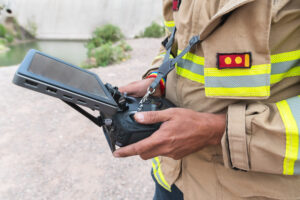
Drone Pre-Flight Checklist/Drone Safety Guide
1. Drone Battery Check
Charge Level: Ensure the drone battery is fully charged before each flight. Most drones have indicators (LED lights or apps) to show the battery level.
Inspect for Damage:
Look for swelling, cracks, or leaks. If you notice any damage, do not use the battery.
Clean Contacts: Ensure the battery contacts are clean and free from debris to prevent connection issues.
Check Battery Health: Use the drone’s app or controller to check battery health and performance degradation.
Proper Storage: Store drone batteries in a cool, dry place and avoid extreme temperatures.
2. Propeller Inspection for Drone Safety
Visual Inspection: Scan for cracks, chips, or wear and tear. Even a small nick can impact flight performance.
Check for Warping: Ensure drone blades aren’t bent or deformed.
Secure Attachment: Confirm each drone propeller is snug and secure on the motor. Give it a gentle twist to ensure it’s tight.
Cleanliness: Wipe off dirt or debris for smoother flights.
Spin Test: Power up the motors and observe smooth rotation and listen for unusual noises.
3. Drone Sensor and GPS Calibration
Calibrate Sensors: Calibrate the drone compass and IMU (Inertial Measurement Unit) as per manufacturer guidelines.
GPS Signal: Ensure a strong GPS signal before takeoff.
4. Camera and Gimbal Check
Secure Mounting: Ensure the drone camera is properly mounted and the gimbal is functioning correctly.
Clean Lens: Ensure there are no obstructions or smudges on the drone camera lens.
5. Drone Firmware and Communication
Firmware Update: Ensure the drone’s firmware is up to date.
Controller Communication: Verify the drone remote controller is paired and communicating with the UAV.
6. Weather and Airspace Check for Safe Drone Operations
Weather Conditions: Check the weather forecast for safe drone flying conditions.
Airspace Clearance: Plan your flight path and ensure you have the necessary permissions for UAV operations.
7. Final Walkaround Drone Inspection
Visual Inspection: Check for visible damage or loose parts on the drone arms, propellers, and body.
Propeller Security: Confirm each drone propeller is securely attached and undamaged.
Landing Gear: Ensure the landing gear is properly attached and stable.
Camera and Gimbal Movement: Verify smooth gimbal movement and clear camera view.
Battery and Connections: Confirm the drone battery is properly seated and all connections are secure.
Flight Environment: Ensure the drone takeoff zone is clear of obstacles, people, and animals.
Remote Controller: Check that the drone remote controller is fully charged and functioning.
By following this drone pre-flight inspection checklist, you’ll ensure your UAV is in optimal condition for a safe and successful flight.
1. Drone Battery Check
Charge Level: Ensure the drone battery is fully charged before each flight. Most drones have indicators (LED lights or apps) to show the battery level.
Inspect for Damage:
Look for swelling, cracks, or leaks. If you notice any damage, do not use the battery.
Clean Contacts: Ensure the battery contacts are clean and free from debris to prevent connection issues.
Check Battery Health: Use the drone’s app or controller to check battery health and performance degradation.
Proper Storage: Store drone batteries in a cool, dry place and avoid extreme temperatures.
2. Propeller Inspection for Drone Safety
Visual Inspection: Scan for cracks, chips, or wear and tear. Even a small nick can impact flight performance.
Check for Warping: Ensure drone blades aren’t bent or deformed.
Secure Attachment: Confirm each drone propeller is snug and secure on the motor. Give it a gentle twist to ensure it’s tight.
Cleanliness: Wipe off dirt or debris for smoother flights.
Spin Test: Power up the motors and observe smooth rotation and listen for unusual noises.
3. Drone Sensor and GPS Calibration
Calibrate Sensors: Calibrate the drone compass and IMU (Inertial Measurement Unit) as per manufacturer guidelines.
GPS Signal: Ensure a strong GPS signal before takeoff.
4. Camera and Gimbal Check
Secure Mounting: Ensure the drone camera is properly mounted and the gimbal is functioning correctly.
Clean Lens: Ensure there are no obstructions or smudges on the drone camera lens.
5. Drone Firmware and Communication
Firmware Update: Ensure the drone’s firmware is up to date.
Controller Communication: Verify the drone remote controller is paired and communicating with the UAV.
6. Weather and Airspace Check for Safe Drone Operations
Weather Conditions: Check the weather forecast for safe drone flying conditions.
Airspace Clearance: Plan your flight path and ensure you have the necessary permissions for UAV operations.
7. Final Walkaround Drone Inspection
Visual Inspection: Check for visible damage or loose parts on the drone arms, propellers, and body.
Propeller Security: Confirm each drone propeller is securely attached and undamaged.
Landing Gear: Ensure the landing gear is properly attached and stable.
Camera and Gimbal Movement: Verify smooth gimbal movement and clear camera view.
Battery and Connections: Confirm the drone battery is properly seated and all connections are secure.
Flight Environment: Ensure the drone takeoff zone is clear of obstacles, people, and animals.
Remote Controller: Check that the drone remote controller is fully charged and functioning.
By following this drone pre-flight inspection checklist, you’ll ensure your UAV is in optimal condition for a safe and successful flight.